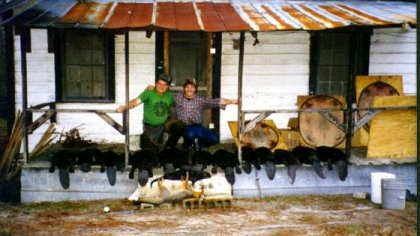
1998 Southern Trapping

Harvey and Todd on the porch of our Skinning Shack
Since this was our first year down here we didn't know quite what to expect. Our main objective was to trap beaver for the landowner. Not knowing for sure what kind of land trapping opportunities there might be, I only brought about 18 1-1/2 coils along.
Harv & Todd trapped with me for the first 10 days and then headed back to the snow and cold weather. We managed to catch about 130 beaver. Harv was the Champion Otter trapper, he managed to catch 5 of them. We caught about 20 fox (reds and greys). Neither Todd nor Harv had ever caught a grey fox before, so it was new for them. Harv also had a nice bobcat in a trap but it pulled out just as we were approaching the set. I managed to catch two bobcats after the boys left. I also took some otter, fox, and more beaver. It was a learning experience for all of us!
OUR HOST
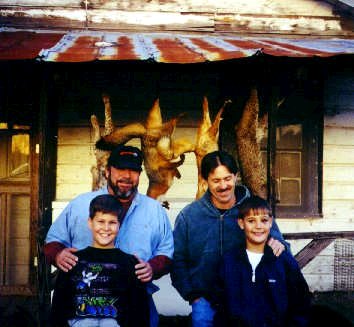
On the left is Carlisle (the landowner) and the boys are two of his sons, Koty and Kyle. Top right is Carlisle's friend Jamie.
Thanks to Carlisle, we had about 15,000 acres of land available to us. The main crops are tobacco, cotton, soybeans and winter wheat. Most of this land is flat, and all ditched, so beaver create a lot of problems.
While we were there, the temperature during the day stayed pretty much in low to mid 60's with a day or two hitting 70. At night it was in the 30's and 40's. Trapping in short sleeved shirts was a real novelty for us. Luckily it was still too cool for snakes to be out! My buddy Charlie had warned me not to put my hand in any place that I couldn't see clearly. We had a few encounters with fire ants, which we don't have up North, they sure do bite for such little critters.
Since this was a family vacation, we rented a Beach House on the Ocean and our wives did their own thing during the day , and the 3 of us drove about 50 miles each way to where we trapped every day.
Southern Grey Fox
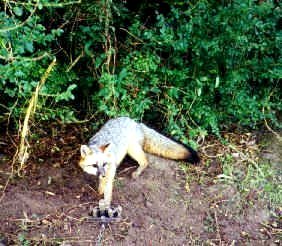
Grey fox are the predominant fox in this country, with an odd red fox appearing occasionally. There was a market for live fox, but we didn't really know that the first year, so we skinned them and brought them home. Most of the fox we put up on site, but we could see we were going to have a big problem as we were catching so many beaver each day we couldn't get them all put up. Carlisle solved that problem for us by bringing us a freezer for the front porch of the skinning shack. We tried to put up some of the fur, but the drying conditions and lack of a heat source made processing fur a little difficult. Most got skinned, rolled up and frozen.
Beaver Set
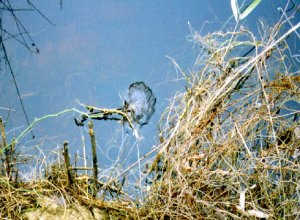
A typical 330 caster mound set. This particular set we called the "Dead Dog set" because it happened that when we found this spot, we also found a dead dog on the other side of the road. This set took 19 Beaver over a three week period. I was quite surprised because when I made the set, there was no beaver sign anywhere around. In this country beaver don't put up any feed beds since it doesn't freeze up, they just travel and eat as they go.
Most of the land is so rough and rugged that once you get off the road, it's almost impossible to travel due to the heavy underbrush. Seems like everything that grows has large thorns!
Typical Fox & Cat Location
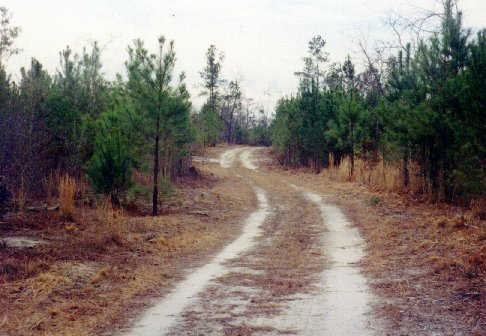
Land that isn't farmed is usually heavily timbered. The parcels of land are owned by timber companies and leased by hunting clubs. Access to these lands is by permission only and is behind locked gates. As we got more well-known in the area, we got permission from several hunt clubs to trap on their land. In some cases timber companies do pay a bounty on beaver, but we never go involved since some local trappers do work for the timber companies.
Most of our land trapping was done using modified step-down dirthole sets. Snares are illegal. Just about every lure and bait we tried was effective as these animals have never experienced any trapping pressure.
I decided that next year I'd stay for two months and really work the fox and cats.
Harvey Roggenkamp wrote a good story about our Trapping Adventure titled "Beaver in the Southern Pines" which was published in the Nov/Dec 1998 issue of the American Trapper, NTA's magazine. You might enjoy looking it up :-)